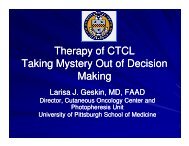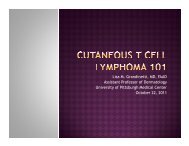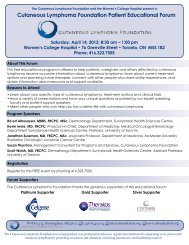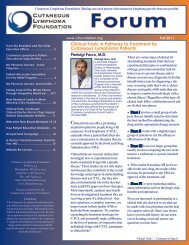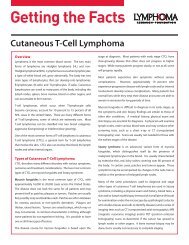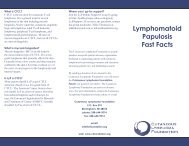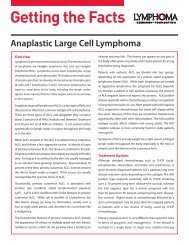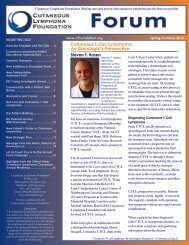Download PDF - Cutaneous Lymphoma Foundation
Download PDF - Cutaneous Lymphoma Foundation
Download PDF - Cutaneous Lymphoma Foundation
Create successful ePaper yourself
Turn your PDF publications into a flip-book with our unique Google optimized e-Paper software.
<strong>Cutaneous</strong> <strong>Lymphoma</strong> <strong>Foundation</strong>: Making sure each person with cutaneous lymphoma gets the best care possible<br />
Forum<br />
www.clfoundation.org Fall 2007<br />
Research Discovers CTCL Incidence Rising in US<br />
From the Executive Director .... 2<br />
Stress Management ................. 3<br />
<strong>Cutaneous</strong> <strong>Lymphoma</strong> Patient<br />
Educational Opportunities ....... 4<br />
Fundraising for the <strong>Cutaneous</strong><br />
<strong>Lymphoma</strong> <strong>Foundation</strong> ............ 5<br />
<strong>Cutaneous</strong> B-Cell<br />
<strong>Lymphoma</strong> Overview ............... 6<br />
The <strong>Cutaneous</strong> <strong>Lymphoma</strong><br />
<strong>Foundation</strong> has funded an<br />
important epidemiology study that<br />
shows that the number of new cases<br />
of CTCL has doubled. In this study,<br />
published in the July 2007 issue of the<br />
Archives of Dermatology, Drs. Vincent<br />
Criscione and Martin Weinstock of<br />
Brown University report that there are<br />
approximately 1,600 new cases of CTCL<br />
diagnosed each year in the United States.<br />
This represents over double the number<br />
of new cases in the past fifteen years.<br />
In their study, Criscione and<br />
Weinstock describe incidence trends (or<br />
the rate at which this disease occurs) for<br />
CTCL in the United States from 1973<br />
to 2002.They determined that the overall<br />
annual incidence<br />
of CTCL was 6.4<br />
…there are<br />
per million, a total<br />
of 0.14 percent of<br />
all cancers, and<br />
3.9 percent of<br />
non-Hodgkins<br />
lymphomas. This<br />
represents a more<br />
than doubling of the incidence since the<br />
last study that was conducted in 1992.<br />
Cases of CTCL was higher among<br />
blacks and men. Racial differences<br />
decreased with age and have not<br />
changed over time. Gender differences<br />
in incidence increase with age and<br />
have decreased over time. Geographic<br />
variation in incidence was found and<br />
correlated with high physician density,<br />
high family income, high percentage of<br />
the population with a bachelor’s degree,<br />
and high home values.<br />
The exact cause for the observed<br />
approximately 1,600<br />
new cases of CTCL<br />
diagnosed each year…<br />
increase in CTCL incidence is unknown<br />
and cannot be determined from this<br />
epidemiology study. However, the<br />
findings do provide an important<br />
framework for investigators to design<br />
new clinical and experimental studies.<br />
It also draws much needed attention to<br />
CTCL and may contribute to greater<br />
resources for research.<br />
The study did not address other<br />
important epidemiologic factors of<br />
CTCL such as death rate, prevalence<br />
(number of patients with CTCL) and<br />
factors influencing survival. Case-control<br />
studies of the 1990s have demonstrated<br />
that a complete response in patients<br />
diagnosed with Stage IA CTCL (less<br />
than 10% body surface area involvement)<br />
correlates with<br />
a lack of disease<br />
progression and<br />
a normal life<br />
span. Recent<br />
combinations of<br />
biologic therapies<br />
appear to have<br />
prolonged survival<br />
in advanced stages of CTCL. Future<br />
studies are needed to determine death<br />
rate, prevalence and the impact of<br />
treatment on CTCL survival.<br />
Because this study was funded by<br />
the <strong>Cutaneous</strong> <strong>Lymphoma</strong> <strong>Foundation</strong>,<br />
it represents tangible evidence of the<br />
<strong>Foundation</strong>’s capacity to partner with<br />
physicians and scientists to advance<br />
the agenda of CTCL. The <strong>Cutaneous</strong><br />
<strong>Lymphoma</strong> <strong>Foundation</strong> looks forward<br />
to continuing its relationship with<br />
investigators and funding meritorious<br />
research in the future.
<strong>Cutaneous</strong> <strong>Lymphoma</strong> <strong>Foundation</strong><br />
Forum<br />
The newsletter of the <strong>Cutaneous</strong> <strong>Lymphoma</strong> <strong>Foundation</strong><br />
ALL RIGHTS RESERVED<br />
DESIGNER & EDITORIAL DIRECTOR<br />
Amanda L. J. Kik<br />
MEDICAL EDITOR<br />
Stuart Lessin, M.D.<br />
<strong>Cutaneous</strong> <strong>Lymphoma</strong> <strong>Foundation</strong> is a 501(c)(3)<br />
non-profit organization. Donations are tax deductible<br />
to the extent allowed by law.<br />
SCIENTIFIC ADVISORY BOARD<br />
Thomas Anderson, M.D. University of Michigan<br />
Kevin Cooper, M.D.<br />
Madeleine Duvic, M.D.<br />
Francine Foss, M.D.<br />
Lars French, M.D.<br />
Sam Hwang, M.D., Ph.D.<br />
Robert Knobler, M.D.<br />
Thomas Kupper, M.D.<br />
Liliane Laroche, M.D.<br />
Stuart Lessin, M.D.<br />
Sue McCann, MSN, RN<br />
Lauren Pinter-Brown, M.D.<br />
Pierluigi Porcu, M.D.<br />
David Ramsay, M.D.<br />
Alain Rook, M.D.<br />
Steven T. Rosen, M.D.<br />
Marianne Tawa, MSN, RN, ANP<br />
Martin Weinstock, M.D., Ph.D.<br />
Sean Whittaker, M.D., MRCP<br />
Lynn Wilson, M. D., MPH<br />
Case Western Reserve University<br />
MD Anderson Cancer Center<br />
Yale University School of Medicine<br />
Geneva Medical Center<br />
National Institutes of Health<br />
University of Vienna<br />
Brigham and Women’s Hospital<br />
University of Paris<br />
Fox Chase Cancer Center<br />
University of Pittsburgh Medical Center<br />
UCLA Medical Center<br />
Ohio Sate University<br />
New York University<br />
University of Pennsylvania<br />
Northwestern University<br />
Dana Farber Cancer Institute, Boston<br />
Brown University<br />
Guys & St. Thomas Hospital<br />
Yale University School of Medicine<br />
<strong>Cutaneous</strong> <strong>Lymphoma</strong> <strong>Foundation</strong><br />
PO Box 374<br />
Birmingham, MI 48012-0374<br />
telephone: (248) 644-9014<br />
fax: (248) 644-9014<br />
email: info@clfoundation.org<br />
www.clfoundation.org<br />
Forum is published by the<br />
<strong>Cutaneous</strong> <strong>Lymphoma</strong> <strong>Foundation</strong>.<br />
Because each person’s body and response to treatment is<br />
different, no individual should indulge in self-diagnosis<br />
or embark upon any course of medical treatment that is<br />
described in Forum without first consulting with his or<br />
her physician.<br />
<strong>Cutaneous</strong> <strong>Lymphoma</strong> <strong>Foundation</strong> is not responsible for<br />
the medical care or treatment of any individual.<br />
From the Executive Director<br />
am so pleased that the <strong>Cutaneous</strong><br />
I <strong>Lymphoma</strong> <strong>Foundation</strong> was able to<br />
fund the epidemiology study by Drs.<br />
Vincent Criscione and Martin Weinstock<br />
of Brown University. It has made a large<br />
impact in the cutaneous lymphoma community.<br />
We knew that lymphoma in general<br />
had increased, but had not been able<br />
to confirm that this was true of CTCL<br />
until now. We will continue supporting projects to gather more<br />
information about our disease.<br />
When we first started the Mycosis Fungoides <strong>Foundation</strong>,<br />
almost 10 years ago, we didn’t realize that there was no organization<br />
specific to the other cutaneous lymphomas. We have put together a<br />
lot of information about CTCL, considering this is a rare disease. It<br />
has been more difficult to gather information about CBCL, which<br />
is even less common. The article in this issue by Dr. Steven M.<br />
Horwitz is a start, and we will compile additional resources in the<br />
future.<br />
In this issue of Forum, Leora Lowenthal writes about stress.<br />
As I was reading it, I wondered if she was writing about me. I have<br />
tried tapes, books and lists and found that it took too much time<br />
and was stressing me out! Now I just take one day at a time and<br />
don’t spend a lot of time worrying about what may happen tomorrow.<br />
When I look ahead at our schedule for this fall, I am amazed<br />
that we were able to put together six educational events along with<br />
all the other medical meetings we will be attending. We have two<br />
scheduled for the same day! We are able to accomplish this because<br />
we have a couple of staff people, Amanda and Holly, who are very<br />
efficient and competent in their jobs. We also have a working Board<br />
of Directors who volunteer their time to make sure we are on track<br />
to “make sure each person with cutaneous lymphoma gets the best<br />
care possible.” We are fortunate to receive grants from companies<br />
to help cover the expenses involved in bringing this opportunity to<br />
patients to interact with specialists and learn more about their disease.<br />
We are planning our 2008 schedule to include more geographical<br />
locations to make it easier for people to attend. I hope you all<br />
will get to attend one of our educational forums in the near future.<br />
By the time this newsletter goes to press, a friend of mine will<br />
have said goodbye to her 19 year old son for the last time. He has a<br />
rare pediatric disease that is always fatal. They have no hope…everything<br />
that could be done has been done. It is a stark contrast to<br />
what is being done in cutaneous lymphomas. In the past few years,<br />
we have had better diagnoses and treatment<br />
and fewer patients are dying from our<br />
disease. There is a tremendous amount of<br />
research out there and more than ever<br />
before, there is hope for the future.<br />
2<br />
The <strong>Cutaneous</strong> <strong>Lymphoma</strong> <strong>Foundation</strong> Forum is made possible by an unrestricted educational grant from Eisai
Forum, Summer 2007<br />
Stress Management<br />
University Cancer Institute.<br />
Leora Lowenthal<br />
sits on the<br />
<strong>Cutaneous</strong><br />
<strong>Lymphoma</strong><br />
<strong>Foundation</strong> Board<br />
of Directors<br />
and is a Senior<br />
Social Worker<br />
at the New York<br />
This past June I was invited to<br />
speak at an educational forum<br />
which was being presented by the<br />
<strong>Lymphoma</strong> Research <strong>Foundation</strong> and<br />
the <strong>Cutaneous</strong> <strong>Lymphoma</strong> <strong>Foundation</strong>.<br />
The topic I was asked to address was<br />
“managing stress” which initially seemed<br />
like a very straightforward matter.<br />
Most oncology social workers learn<br />
about this in their training both for the<br />
benefit of their clients and themselves;<br />
it’s considered an essential “trick of<br />
the trade.” So, I confidently set about<br />
working on my slides and started trying<br />
to think of personal anecdotes and<br />
references I could use to demonstrate<br />
the fine art of stress management. That’s<br />
when I first noticed some patterns in<br />
my history.<br />
I found myself remembering the<br />
“relaxation CD” I purchased which<br />
featured the sound of breaking waves.<br />
Unfortunately I discovered that the<br />
sound of waves crashing through my<br />
apartment caused me to feel quite<br />
jumpy. Then there was the time I took<br />
a yoga class but was so chronically<br />
overtired that I would fall asleep as soon<br />
as we began floor exercises. I even kept a<br />
journal for a while but was consumed by<br />
paranoid fears that someone would find<br />
it and read it. You get the picture; I was<br />
a study in failed attempts at<br />
stress management<br />
I also contemplated the many pieces<br />
of advice that I offer almost daily which<br />
I don’t seem able to apply in my own<br />
life. I am a great believer in the value<br />
of making lists and schedules in order<br />
to avoid the stress of being forgetful.<br />
Yet in fact<br />
I almost<br />
always<br />
forget to<br />
make lists<br />
and when<br />
I do I tend<br />
to misplace<br />
them before<br />
any items have been crossed off. I also<br />
advise people that it is important to<br />
observe and respect the natural limits<br />
of our bodies. If you’re tired, I say take<br />
a nap or go to bed early! I usually say<br />
this as I am gulping down a caffeinated<br />
beverage and silently cursing my own<br />
foolish tendency to stay up well past<br />
anyone’s bedtime. In truth, throughout<br />
the 1990s my favorite form of stress<br />
management was chain-smoking far into<br />
the night (ironically, quitting smoking<br />
was extremely stressful.)<br />
Needless to say after a few hours of<br />
musing I was convinced that I should<br />
never speak on stress management again.<br />
I imagined hordes of people leaving the<br />
workshop armed with new, disastrous<br />
techniques sure to guarantee a life full of<br />
stress and exhaustion. There was only<br />
one thing which suggested a reason for<br />
hope and it was this: in general, despite<br />
being a slightly neurotic, insomniac<br />
workaholic, I am a pretty happy person<br />
with well-managed stress levels.<br />
So, I won’t bother to describe what<br />
does actually work for me here but I<br />
give a lot of the credit to my beloved<br />
parents, my incredible sister with her<br />
equally incredible husband and children,<br />
my devoted friends and my brilliant,<br />
compassionate colleagues. And, in case<br />
you’re wondering, I went on to present<br />
at the workshop and thankfully no one<br />
has called yet to say that I ruined their<br />
life with my wretched advice. I did offer<br />
up a lot of the usual suspects in stress<br />
management but I added the suggestion<br />
that everyone do a little search through<br />
their own<br />
I am a great believer in the value of<br />
making lists and schedules in order to<br />
avoid the stress of being forgetful. Yet in<br />
fact I almost always forget to make lists<br />
and when I do I tend to misplace them<br />
before any items have been crossed off.<br />
memory<br />
archives.<br />
Look at<br />
your past<br />
efforts to<br />
manage<br />
stress and<br />
consider<br />
what hasn’t or hasn’t worked for you.<br />
Know your own strengths and exploit<br />
them. Never be afraid to ask for help<br />
or to take suggestions; people in the<br />
audience offered up some great ideas<br />
that I had never considered. And, most<br />
important of all, never let lymphoma<br />
become the most important thing in your<br />
life. You don’t have to like lymphoma<br />
but you can like, maybe even love, your<br />
life with it. Wishing you all a very lovely,<br />
stress-free autumn.<br />
<strong>Lymphoma</strong> Awareness<br />
World <strong>Lymphoma</strong><br />
Awareness Day is<br />
held on September<br />
15 every year and is<br />
a day dedicated to<br />
raising awareness of<br />
lymphoma. WLAD<br />
is a global initiative<br />
hosted by the <strong>Lymphoma</strong> Coalition,<br />
a non-profit network organization<br />
of patient groups from around the<br />
world. For further information, visit<br />
www.lymphomacoalition.org.<br />
3
<strong>Cutaneous</strong> <strong>Lymphoma</strong> <strong>Foundation</strong><br />
<strong>Cutaneous</strong> <strong>Lymphoma</strong> Patient Educational Opportunities<br />
September 15, 2007<br />
San Francisco, CA<br />
<strong>Lymphoma</strong> Workshop, presented with<br />
the <strong>Lymphoma</strong> Research <strong>Foundation</strong><br />
Speakers: Youn Kim, MD, Stanford<br />
University, additional speakers TBA<br />
September 22, 2007<br />
Columbus, OH<br />
<strong>Cutaneous</strong> <strong>Lymphoma</strong> Patient<br />
Educational forum<br />
Speakers: Pierluigi Porcu, M.D, Ohio<br />
State University, Christiane Querfeld,<br />
Northwestern University, John Zic,<br />
Vanderbilt Univeristy<br />
October 12 – 14, 2007<br />
Brooklyn, NY<br />
North American Educational Forum<br />
on <strong>Lymphoma</strong> presented by the<br />
<strong>Lymphoma</strong> Research <strong>Foundation</strong><br />
Speakers: David Straus, MD, Memorial<br />
Sloan Kettering Cancer Center, David<br />
Ramsay, MD, New York University School of Medicine,<br />
Kennth Hymes, MD New York University School of Medicine,<br />
JoAnn Latkowski, MD, New York University School of<br />
Medicine, Leora Lowenthal, LCSW, OSW-C, New York<br />
University Cancer Institute<br />
October 20, 2007<br />
Pittsburgh, PA<br />
10th Annual Jegasothy Support<br />
Group for CTCL<br />
Speakers include: Larisa Geskin, MD,<br />
University of Pittsburgh Medical Center,<br />
Sue McCann, MSN, RN, University of<br />
Pittsburgh Medical Center, additional speakers TBA<br />
October 20, 2007<br />
Calgary, AB<br />
Living with <strong>Lymphoma</strong>: The Journey<br />
Forward, presented with the<br />
<strong>Lymphoma</strong> <strong>Foundation</strong> Canada<br />
Speaker: Richard Haber, MD<br />
November 3, 2007<br />
Minneapolis, MN<br />
<strong>Lymphoma</strong> Workshop, presented with<br />
the <strong>Lymphoma</strong> Research <strong>Foundation</strong><br />
Speakers: TBA<br />
Webinar: Focus on Topical Therapies<br />
Date and Time:<br />
Monday, September 17, 2007, 2pm ET • 11am PT<br />
Program Chair:<br />
Stuart Lessin, MD, Fox Chase Cancer Center<br />
Registration Instructions:<br />
This program is free-of-charge; however, pre-registration is<br />
required. Visit www.clfoundation.org/THwebinar<br />
What is a webinar?<br />
A webinar is an interactive online seminar. All you need is a<br />
telephone and an internet connection. Once you have registered,<br />
you will be provided with instructions for how to log on<br />
to and participate in the webinar.<br />
What will happen during this webinar?<br />
This webinar will provide an overview of topical therapies that<br />
are used to treat cutaneous lymphoma. Both patients and caregivers<br />
are welcome to attend this free event. Dr. Stuart Lessin<br />
will speak about the treatments. This will be followed up with<br />
a question and answer session and include a brief presentation<br />
by the <strong>Cutaneous</strong> <strong>Lymphoma</strong> <strong>Foundation</strong>.<br />
For more information about these events, please<br />
visit our website, www.clfoundation.org,<br />
or email us at education@clfoundation.org,<br />
or call (248)644-9014<br />
Patient Educational Forums provide exceptional opportunities<br />
for people with cutaneous lymphoma to receive accurate<br />
information about treatment options, access experts in the<br />
field and connect with other people with similar experiences.<br />
<strong>Cutaneous</strong> <strong>Lymphoma</strong> <strong>Foundation</strong> Patient Education<br />
Forums key features:<br />
Half-day to day-long event<br />
Held in cities throughout North America<br />
Professional and lay speakers<br />
Format includes lectures, Q&A sessions and<br />
small-group discussions<br />
Objectives:<br />
• Develop a better understanding of diagnostic tests.<br />
• Learn about treatments available for different stages.<br />
• Identify resources for treatment and support.<br />
These educational opportunities are made possible by generous unrestricted educational grants from:<br />
Platinum Sponsors: Eisai Inc. and Ovation Gold Sponsors: Therakos and Merck Oncology Silver Sponsor: Gloucester<br />
4
Forum, Summer 2007<br />
Fundraising for the <strong>Cutaneous</strong> <strong>Lymphoma</strong> <strong>Foundation</strong><br />
Christopher Shipp<br />
is Vice President<br />
for the <strong>Cutaneous</strong><br />
<strong>Lymphoma</strong><br />
<strong>Foundation</strong> and a<br />
Senior Consultant<br />
at a leading health<br />
care marketing<br />
research company<br />
You may recall hearing about Scott,<br />
a young man living with CTCL<br />
who decided to run a half marathon this<br />
summer in order to increase awareness<br />
and to raise money for the <strong>Cutaneous</strong><br />
<strong>Lymphoma</strong> <strong>Foundation</strong>. Scott<br />
completed the half marathon and raised<br />
over $22,000 for<br />
the <strong>Foundation</strong>.<br />
These funds will<br />
serve to educate<br />
and support<br />
patients, provide<br />
continuing<br />
education for<br />
physicians and nurses, and fund ongoing<br />
clinical research. Because the <strong>Cutaneous</strong><br />
<strong>Lymphoma</strong> <strong>Foundation</strong> is a small non<br />
profit organization and because we<br />
depend on your donations to continue<br />
to serve people with CTCL, donations<br />
and fund raising are our life blood and<br />
contributions such as Scott’s are vital.<br />
As a CTCL patient, I was inspired<br />
by Scott’s effort, and as a <strong>Cutaneous</strong><br />
<strong>Lymphoma</strong> <strong>Foundation</strong> board member,<br />
I was awed by the amount of money he<br />
was able to raise for the <strong>Foundation</strong>.<br />
After a few email and telephone<br />
conversations with Scott and his family,<br />
I came to the conclusion that Scott’s<br />
accomplishment could be replicated by<br />
other CTCL patients and/or their loved<br />
ones if they so desired.<br />
To test my theory, I decided to try<br />
it out for myself. My first task was to<br />
choose an event, so I signed up for a<br />
A single person can<br />
make a difference.<br />
Scott has proven that.<br />
triathlon (I have not done one of these<br />
since being diagnosed in 2004, so wish<br />
me luck). The second step was to go to<br />
www.firstgiving.com. This is a website<br />
that works in conjunction with nonprofit<br />
organizations to accept donations on<br />
behalf of people participating in some<br />
type of fundraising event. It is easy,<br />
it costs you nothing, and all you have<br />
to do is follow the simple step-by-step<br />
instructions and Firstgiving will host<br />
your personal fundraising page that<br />
allows you to accept donations on<br />
behalf of the <strong>Cutaneous</strong> <strong>Lymphoma</strong><br />
<strong>Foundation</strong> without having to handle<br />
any of the money personally. Once<br />
your page is setup, the next step is to<br />
email the link to<br />
anyone you think<br />
would be willing<br />
to donate. It is<br />
that simple. You<br />
can check out<br />
my page as an<br />
example at www.<br />
firstgiving.com/cutaneouslymphomafou<br />
ndation. It is fun to monitor my progress<br />
with family and friends and it is inspiring<br />
to see how generous people truly are.<br />
I realize not everyone is able or<br />
inclined to compete in athletic events<br />
to raise money for the <strong>Cutaneous</strong><br />
<strong>Lymphoma</strong> <strong>Foundation</strong>. If this is the<br />
case, and you still want to help the<br />
<strong>Foundation</strong> by fundraising on your own,<br />
you are only limited by your initiative<br />
and creativity. Examples of fundraising<br />
activities done on behalf of other non<br />
profit organizations include; bake<br />
sales, car washes, wine tastings, silent<br />
auctions, garage sales, raffles, etc., where<br />
the proceeds go directly to the non profit<br />
organization.<br />
A single person can make a<br />
difference. Scott has proven that. I hope<br />
the ideas and information provided in<br />
this article, will give others the tools they<br />
Scott single-handedly raised<br />
over $20,000 for the <strong>Cutaneous</strong><br />
<strong>Lymphoma</strong> <strong>Foundation</strong> running a half<br />
marathon in New York this summer.<br />
need to follow in his footsteps. It is the<br />
<strong>Foundation</strong>’s goal to continually enhance<br />
and expand the services we provide to<br />
patients and the only way we can do that<br />
is through your support.<br />
5
<strong>Cutaneous</strong> <strong>Lymphoma</strong> <strong>Foundation</strong><br />
<strong>Cutaneous</strong> B-Cell <strong>Lymphoma</strong> Overview<br />
Steven M<br />
Horwitz, M.D.,<br />
is an oncologist at<br />
Memorial Sloan<br />
Kettering Cancer<br />
Center in New<br />
York City<br />
Among all the types of non-<br />
Hodgkin’s lymphomas, B-cell<br />
lymphomas are much more common<br />
than T-cell lymphomas. However, in<br />
the skin, it is the B-cell lymphomas that<br />
are more unusual. B-cell lymphomas<br />
which are completely confined to the<br />
skin are called primary cutaneous B-cell<br />
lymphomas or CBCL. It is important<br />
to note that systemic or nodal B-cell<br />
lymphomas can secondarily involve<br />
the skin and these would not be called<br />
primary cutaneous or CBCL. Under<br />
the microscope, CBCL look like the<br />
more common nodal B-cell lymphomas<br />
but often act differently. In the past<br />
these differences were not always well<br />
recognized. Recently, a consensus<br />
classification system between the<br />
World Health Organization (WHO)<br />
and European Organization for the<br />
Treatment and Research of Cancer<br />
(EORTC) systems was published.<br />
This new system lists three primary<br />
types of CBCL: primary cutaneous<br />
marginal zone B-cell lymphoma<br />
(CMZL), primary cutaneous follicle<br />
center lymphoma (CFCL), and primary<br />
cutaneous diffuse large cell lymphoma,<br />
leg type (LBCB-L).<br />
Indolent Primary<br />
<strong>Cutaneous</strong> B-cell <strong>Lymphoma</strong>s<br />
CMZL and CFCL are generally<br />
very slow growing and are thus<br />
considered indolent. They respond well<br />
to treatment, often mild treatments<br />
when it is needed, but often return or<br />
relapse. These relapses of the indolent<br />
CBCL are almost always confined<br />
to the skin only and are rarely lifethreatening.<br />
Because these lymphomas<br />
usually grow slowly and often return,<br />
even after effective therapy, sometimes<br />
no treatment is needed.<br />
Primary <strong>Cutaneous</strong><br />
Follicle Center <strong>Lymphoma</strong><br />
Primary <strong>Cutaneous</strong> Follicle Center<br />
<strong>Lymphoma</strong> (CFCL) is the most<br />
common B-cell lymphoma to occur as a<br />
primary tumor of the skin. CFCL most<br />
commonly presents on the head and neck<br />
or trunk with the legs rarely involved.<br />
Lesions appear as pink or red nodules<br />
or tumors that develop slowly over<br />
months to years. They rarely develop<br />
open sores or ulcers. Some patients may<br />
have nodules in many places, more often<br />
a single tumor or small group of papules<br />
or nodules is seen.<br />
Marginal Zone <strong>Lymphoma</strong><br />
Primary cutaneous marginal zone<br />
lymphoma (CMZL) is slow growing<br />
B-cell lymphoma that is similar to<br />
a type of non-Hodgkin’s lymphoma<br />
called an extranodal lymphomas of<br />
Mucosa Associated Lymphoid Tissue<br />
(MALT) type. CMZL are the second<br />
most common form of CBCL. People<br />
with CMZL present with pink or red<br />
papules, nodules, and/or tumors. Ulcers<br />
are rare . CMZL can occur at anywhere<br />
on the skin but have a predilection for<br />
the extremities, particularly the arms,<br />
and the trunk. Single or multiple lesions<br />
may be present. Lesions may present<br />
acutely or may be present for years<br />
before diagnosis.<br />
Aggressive Primary<br />
<strong>Cutaneous</strong> B-cell <strong>Lymphoma</strong><br />
Diffuse large cell lymphoma, leg<br />
type or LBCL-L is a rare and potentially<br />
more dangerous type of CBCL that<br />
differs from the indolent types by its<br />
appearance on the skin and under the<br />
microscope.<br />
Primary <strong>Cutaneous</strong> Diffuse Large<br />
B-cell <strong>Lymphoma</strong>, Leg Type<br />
LBCL-L was initially recognized<br />
as a more aggressive disease often<br />
showing up in the legs of elderly women,<br />
which is where its name comes from.<br />
We now can recognize this type of<br />
lymphoma on careful pathology review<br />
including some unique molecular<br />
features that distinguish it from the<br />
more common indolent subtypes. While<br />
LBCL-L most often shows up on the<br />
legs we must remember that this type<br />
can occur at any site of the skin and the<br />
indolent types can first show up on the<br />
legs so site alone is not enough to make<br />
the diagnosis. LBCL-L often develop<br />
into large tumors with extension deep<br />
into the fat. They tend to grow quickly,<br />
over weeks to months and frequently<br />
develop open sores. Unlike the indolent<br />
types, they have a high likelihood of<br />
spreading outside the skin.<br />
Primary <strong>Cutaneous</strong> Diffuse Large<br />
B-Cell <strong>Lymphoma</strong> Other<br />
Primary <strong>Cutaneous</strong> Diffuse Large<br />
B-Cell <strong>Lymphoma</strong>, Other, describes<br />
a group of rare diffuse large B-cell<br />
lymphomas that do not fit into any other<br />
categories. These lymphomas, while at<br />
times showing up in the skin are more<br />
often systemic lymphomas that have<br />
gone to the skin.<br />
6
Forum, Summer 2007<br />
Diagnosis<br />
Appropriate biopsy of skin<br />
involvement is critical for the diagnosis<br />
and classification of CBCL. Whenever<br />
possible, one should perform an<br />
incisional biopsy or large punch rather<br />
than a small punch or shave biopsy<br />
because more tissue is often be needed<br />
for detailed pathology studies.<br />
Staging evaluation<br />
Once a diagnosis of B-cell<br />
lymphoma has been established from a<br />
skin biopsy, complete clinical staging<br />
is indicated to exclude disease outside<br />
the skin and define the process as a<br />
primary cutaneous lymphoma. This<br />
should include a physical examination<br />
with attention to the entire skin<br />
and lymphatic system Laboratory<br />
evaluation should include complete<br />
blood counts and serum chemistries as<br />
well as measurement of serum lactate<br />
dehydrogenase (LDH). Imaging studies<br />
should include a CT scan of the chest,<br />
abdomen and pelvis. The neck should be<br />
imaged as well, for disease that presents<br />
in the head or neck region. PET scans<br />
are sometimes useful. A bone marrow<br />
biopsy is often but not always done.<br />
in mind that many people with this<br />
disease are diagnosed in their 80s or 90s<br />
and survival rates at 10 years includes<br />
people who have died from any cause.<br />
Despite the excellent survival rates,<br />
relapses are common with almost 50%<br />
of people having the lymphoma come<br />
back after an initial complete response<br />
to treatment. However relapses are<br />
almost always confined to the skin, and<br />
this in general does not affect prognosis<br />
or survival. Less than 10% of people ever<br />
develop lymphoma outside the skin (the<br />
chance of this is somewhat higher for<br />
people with LBCL-L).<br />
Management<br />
Indolent Types: <strong>Cutaneous</strong> Follicle<br />
Center Cell and <strong>Cutaneous</strong><br />
Marginal Zone <strong>Lymphoma</strong><br />
Radiation therapy works very well<br />
and is often preferred for people with<br />
localized disease. Some people with very<br />
small single lesions may be treated with<br />
excision only. Topical therapies are also<br />
used at times. While radiation therapy is<br />
a recommended approach for localized<br />
therapy, a preferred approach to<br />
systemic therapy is less clear. In general,<br />
systemic chemotherapies of various<br />
types as well as immune therapies such<br />
as monoclonal antibodies and interferon<br />
have all been used successfully for people<br />
with multiple spots. It is important to<br />
note that many therapies can treat the<br />
lymphoma that is present leading to<br />
remission, however no therapy has been<br />
shown to be superior in preventing<br />
the common recurrences. Sometimes<br />
no treatment is needed and people are<br />
observed.<br />
Aggressive Type: Diffuse large cell<br />
lymphoma-leg type<br />
Given the more poor prognosis for<br />
people with CBCB-L, combinations of<br />
chemotherapy are often recommended.<br />
In people with a single tumor, radiation<br />
can be very effective. Often radiation and<br />
chemotherapy are given sequentially and<br />
can be successful and lead to remission.<br />
However, even with successful<br />
treatments, relapses are common and<br />
there is no known best treatment<br />
strategy.<br />
Prognostic and predictive factors<br />
The prognosis for people with<br />
CBCL is usually excellent. Recently,<br />
the Italian Study Group for <strong>Cutaneous</strong><br />
<strong>Lymphoma</strong>s reviewed 467 patients<br />
with CBCL. For people with CMZL<br />
and CFCL about 96% were alive at 5<br />
years after their diagnosis and 90% were<br />
alive 10-years later. People with the<br />
more aggressive LBCL-L had a more<br />
difficult time with 73% alive 5 years after<br />
their diagnosis and 47% alive 10 years<br />
later. While the chance of the lymphoma<br />
becoming life threatening is higher in<br />
people with LBCL-L, one should keep<br />
Behavior<br />
Indolent<br />
Aggressive<br />
Primary <strong>Cutaneous</strong> B-cell <strong>Lymphoma</strong>s<br />
Subtype<br />
Primary cutaneous marginal<br />
zone B-cell lymphoma<br />
Primary cutaneous folicle<br />
center lymphoma<br />
Primary cutaneous diffuse<br />
large B-cell lymphoma, leg<br />
type<br />
Primary cutaneous diffuse<br />
large B-cell lymphoma, other<br />
7
Show your support!<br />
Order your own <strong>Cutaneous</strong> <strong>Lymphoma</strong> <strong>Foundation</strong> jersey.<br />
Simply visit www.clfoundation.org and click on “Shop”<br />
or call 248-644-9014.<br />
Jerseys are available for $92 plus shipping and handling. Please allow 4-6 weeks for delivery.<br />
PO Box 374<br />
Birmingham, MI 48012<br />
NON-PROFIT<br />
US POSTAGE PAID<br />
BIRMINGHAM MI<br />
PERMIT NO 265<br />
TIME SENSITIVE MATERIALS ENCLOSED



